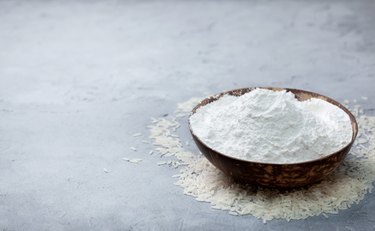
In the battle of the bakes, wheat flour is the clear winner, able to make breads rise to the occasion. But rice flour has its own worthy properties, including being gluten-free. The nutritional value of rice and wheat are similar — the main difference is between whole grain and refined flour.
Refined Versus Whole Grain Flour
Video of the Day
Before delving into the details of rice versus wheat nutrition, it's important to make a distinction. Rice and wheat flours come in different varieties — whole grain and refined.
Video of the Day
Refined white flour is the type that is most common in baking. It's made from whole grain wheat that's been processed to remove the outer hull, called the bran, and the endosperm — the part of the grain that stores nutrients for the growing plant, according to Harvard T.H. Chan School of Public Health. This leaves a grain that is smooth and white in texture and grinds into a very fine powder.
Whole grain wheat is as it sounds — the whole grain. It hasn't been processed — or milled — as refined wheat has been. Therefore it retains all its structural components. As such, it tends to be more coarse than white flour.
Rice also comes as a whole grain or as a refined grain. White rice is basically brown rice that has been milled and polished. This gives it a more tender texture and extends its shelf life.
If you've eaten both types of rice, you know they have a different flavor and texture — brown rice is chewier with a nuttier flavor. These differences translate when the grain is processed into flours.
Refined Rice Versus Wheat Flour
Milling changes the structure and flavor of the grain, and it also removes a lot of the nutrition. With the removal of the bran, most of the fiber is also removed; getting rid of the endosperm eliminates many of the vitamins and minerals whole grains are known for providing.
When comparing the nutritional value of rice and wheat, the refined version and whole grain versions have to be compared separately.
By weight, refined wheat and rice flours are similar in calories, with about 100 per ounce, according to USDA data. The fat in rice and wheat are also similar — less than half a gram per ounce. Rice and wheat are both high in carbohydrates, with 21 to 22 grams per ounce. A little less than a gram of that is fiber.
Their vitamin and mineral contents also do not differ significantly. Refined wheat flour has a bit more potassium, iron and folate. However, neither can be considered a good source of any micronutrients, which is characteristic of refined grains.
Whole Grain Rice Versus Wheat Flour
Comparing the whole grain flours reveals a few more marked differences between wheat and rice. The calories are about the same, but whole grain wheat flour has more protein and fiber. One ounce of whole grain wheat flour has 3.75 grams of protein versus 2 grams of protein in 1 ounce of brown rice flour. An ounce of wheat flour has 3 grams of fiber, while an ounce of brown rice has 1.3 grams of fiber.
Whole grain wheat flour is higher in nearly all vitamins and minerals. It has twice the amount of iron, more than three times the amount of calcium and more than double the amount of the B vitamin folate.
But overall, there aren't significant differences. Both whole grain flours are good sources of additional nutrients in your diet and better choices for your health.
- USDA: "Basic Report: 20481, Wheat Flour, White, All-Purpose, Unenriched"
- USDA: "Basic Report: 20061, Rice Flour, White, Unenriched"
- USDA: "Basic Report: 20080, Wheat Flour, Whole-Grain (Includes Foods for Usda's Food Distribution Program)"
- USDA: "Basic Report: 20090, Rice Flour, Brown"
- Harvard T.H. Chan: "Whole Grains"